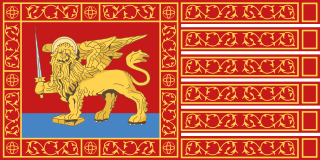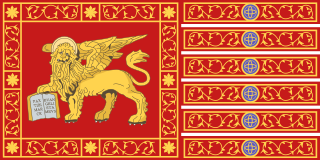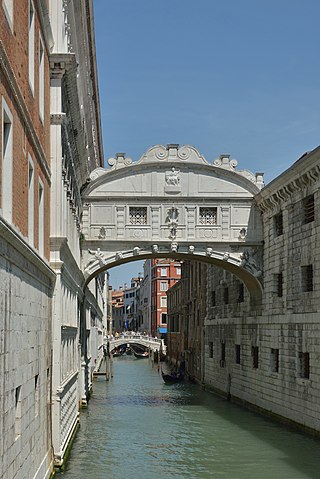
The Republic of Venice, officially the Most Serene Republic of Venice and traditionally known as La Serenìssima, was a sovereign state and maritime republic with its capital in Venice. Founded, according to tradition, in 697 by Paolo Lucio Anafesto, over the course of its 1,100 years of history it established itself as one of the major European commercial and naval powers. Initially extended in the Dogado area, during its history it annexed a large part of Northeast Italy, Istria, Dalmatia, the coasts of present-day Montenegro and Albania as well as numerous islands in the Adriatic and eastern Ionian seas. At the height of its expansion, between the 13th and 16th centuries, it also governed the Peloponnese, Crete and Cyprus, most of the Greek islands, as well as several cities and ports in the eastern Mediterranean.

The Grand Canal is the largest channel in Venice, Italy, forming one of the major water-traffic corridors in the city.

Mazzorbo is one of various islands in the northern part of the Lagoon of Venice. Like the other islands in this part of the lagoon, it was the site of one of the earliest settlements in the lagoon which predated the development of Venice. However, these islands then declined and were eventually abandoned. In the 1980s the architect Giancarlo De Carlo built a brightly coloured residential neighbourhood to help to repopulate Mazzorbo. In 2019 its population was 256. It is linked to Burano by a wooden bridge. It was once an important trading centre but is now known for its vineyards and orchards. Its main attraction is the fourteenth century church of Santa Caterina.

The Council of Ten, or simply the Ten, was from 1310 to 1797 one of the major governing bodies of the Republic of Venice. Elections took place annually and the Council of Ten had the power to impose punishments upon patricians. The Council of Ten had a broad jurisdictional mandate over matters of state security. The Council of Ten and the Full College constituted the inner circle of oligarchical patricians who effectively ruled the Republic of Venice.

Venetian Albania was the official term for several possessions of the Republic of Venice in the southeastern Adriatic, encompassing coastal territories primarily in present-day southern Montenegro and partially in northern Albania.

The Domini di Terraferma was the hinterland territories of the Republic of Venice beyond the Adriatic coast in Northeast Italy. They were one of the three subdivisions of the Republic's possessions, the other two being the original Dogado (Duchy) and the Stato da Màr.

Piombi is a former prison in the Doge's Palace in Venice. The name of the prison refers to its position directly under the roof of the palace, which was covered with slabs of lead. In winter, these slabs let the cold pass and they acted as a conductor in the summer heat, imposing harsh conditions for inmates.

The office of Procurator of Saint Mark was one of the few lifetime appointments in the government of the Venetian Republic and was considered second only to that of the doge in prestige. It was routinely occupied by nobles belonging to the most influential families and typically represented the climax of a distinguished political career, although it was often an intermediate position prior to election as doge.
Venice, which is situated at the north end of the Adriatic Sea, was for hundreds of years the richest and most powerful centre of Europe, the reason being that it gained large-scale profits from the adjacent middle European markets. Venice was the major centre of trade with the Arabs and indirectly the Indians during the Middle Ages. It also served as origin of the economic development and integration of the rest of Europe during the Middle Ages.

The church of Santi Severino e Sossio and the annexed monastery are located on via Bartolommeo Capasso in Naples, Italy.

Santi Biagio e Cataldo or San Biagio e Cataldo was a church on the western corner of the Giudecca island in Venice, Italy. It was dedicated to saint Blaise and saint Catald.
The following is a timeline of the history of the city of Ferrara in the Emilia-Romagna region of Italy.
The following is a timeline of the history of the city of Forlì in the Emilia-Romagna region of Italy.

The Magistrato alla Sanità was the office of the Republic of Venice definitively instituted in 1490 to manage public health in the city of Venice and its territories, with specific attention on preventing the spread of epidemics within the maritime republic. The magistracy was among the first health authorities in Europe to institute public inoculation projects to prevent the spread of infectious diseases.

The Riformatori dello studio di Padova, also Riformatori allo studio di Padova, were the three officials of the Venetian Republic responsible for overseeing education and culture. Created in 1517, initially to reopen the University of Padua after the War of the League of Cambrai, they became responsible over time for public and private schooling at all levels, public libraries in Venice and Padua, intellectual academies, and professional schools. They also reviewed and authorized for publication all books within the mainland territory of Venice.
The Camerlenghi di Comun were senior fiscal officials of the Republic of Venice.

Longhi is an Italian surname of ancient origin, initially spelled as Longo, of which Longhi is plural. Some groups gained great power in the Middle Ages and into the modern era, holding dozens of titles of nobility and vast estates in north-central Italy. The surname appears in many dialectal variants, such as Longis, Longoni, Longa, Longhù, Longi, Longu and others. In addition to the Longus, the plural Longi is usually found in Latin texts. However, since in Italian longo means "long", "tall", "ancient" or "long", and is a word of common usage, it is likely that many of the numerous groups scattered throughout Italy had independent origins.

The State Archives of Milan, based at the Palazzo del Senato, Via Senato n. 10, is the state institution responsible, by law, for the preservation of records from the offices of state bodies, as well as public bodies and private producers. Slowly formed through the agglomeration of the various archival poles spread throughout Austrian Milan between the end of the 18th and the first half of the 19th century, the State Archives finally found its home in the former Palazzo del Senato under the direction of Cesare Cantù in 1886. Having become a research and training center of excellence under the directorships of Luigi Fumi and Giovanni Vittani, the State Archives of Milan since 1945 continued its role as a preservation institution, adapting to the needs of the times and developing the School of Archival Studies, Palaeography and Diplomatics attached to the Institute.



















